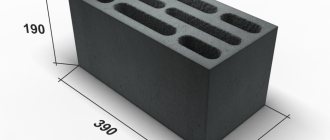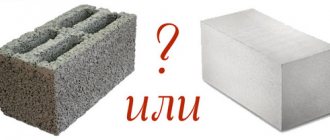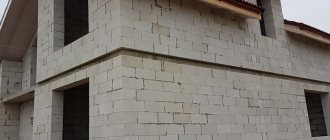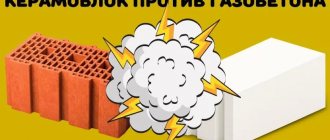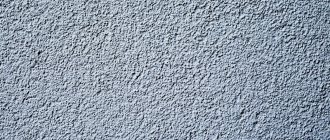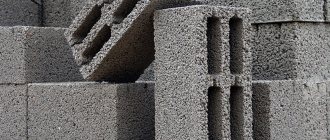The modern construction market offers potential clients many options for materials for the construction of structures. Each of them has characteristic parameters, features of installation and subsequent operation.
Cinder block or expanded clay block are used in the construction of both load-bearing and self-supporting walls in houses with a limited number of floors. Both of these raw materials have partially similar parameters, but, nevertheless, they differ from each other. In order to understand which one is better, you need to study their main characteristics.
Photo of building a house made of expanded clay blocks
What load can an expanded clay concrete block withstand?
So, with a strength of 50 kg per square centimeter, one expanded clay concrete block
with dimensions 390 by 190 by 188,
will withstand a load
of 37,050 kg; ... Usually expanded clay concrete is equal in this indicator to foam and gas silicate blocks.
Interesting materials:
How to properly make drainage in a flower pot? How to properly duplicate a key? How to make an apron in the kitchen? How to take a photo for government services? How to properly make a foundation for an extension to a house? How to make a warranty card correctly? How to properly waterproof before screeding a floor? How to do artificial respiration correctly? How to properly make a drip line on the roof? How to correctly lexicalize a word?
Parameters of building materials
Let's consider the main parameters of expanded clay blocks and cinder blocks.
- Such an indicator as strength is very significant when constructing a building from one or another building material. It demonstrates the degree of compressive load that the block can withstand;
- The conditional density of a block, taking into account the voids present in it, can be determined by its volumetric weight;
- The degree of thermal conductivity determines the amount of heat that will leak through a wall with an area of 1 square meter when the ambient temperature changes by 1 degree;
- Frost resistance can be used to judge the number of freeze/thaw cycles, which can reduce the strength of the block. It is this indicator that determines the useful life of the walls;
- Building blocks shrink , that is, they decrease in size after erecting the walls of the building with your own hands;
- Also significant is how much heat the walls store and how quickly they cool. The longer the walls of the building cool down, the less often you will need to turn on the individual heating system. In this case, energy resources are saved and the comfort of the home increases.
Note! Living will be comfortable in a house in the construction of which raw materials with a high rate of stored heat were used. Indeed, in such a house, temperature changes will be rare, which is especially important when the central heating is turned off seasonally.
- Water absorption shows the amount of moisture that a material can absorb.
Brick, cinder block, foam concrete or wood concrete
Brick houses are durable and reliable. The tensile strength of brick exceeds 30 MPa. Structures made from this material do not need additional reinforcement. The water absorption of brick is less than that of foam block or cinder block.
But the thermal conductivity of the material forces the construction of thick walls. And this is not very advisable. Cinder blocks or foam blocks have dimensions that allow walls to be laid in one block.
Wood concrete does not emit harmful substances, is soundproof and waterproof.
basic information
Expanded clay concrete blocks are a wall material that consists of a mixture of:
- cement;
- sand;
- and expanded clay.
For their production, vibrating machines are used for the production of expanded clay and cinder blocks.
Expanded clay concrete blocks are produced in two types:
- full-bodied;
- and empty.
Used for construction:
- load-bearing walls of buildings;
- partitions;
- openings in a monolithic structure.
Application of expanded clay concrete blocks
The installation instructions for expanded clay concrete blocks provide for their laying with the voids facing down using sand-cement mortar.
Note! The existing voids must not be through, otherwise the mortar may fall inside the wall during laying.
Cinder blocks are a popular construction raw material
Cinder blocks are a wall material that is produced using almost the same technology, only blast furnace slag is used instead of filler.
Dimensions of expanded clay concrete blocks
The sizes of the blocks are regulated by the state standard, depend on the purpose and are equal to:
- for external walls, the typical length can be 30, 40cm, width 30, 20cm, height 20cm;
- for internal walls and partitions, the length is 60, 40, 20 cm, width 9, 12 cm, height 20 cm.
On a note!
The size 40x20x20 cm is most widespread among builders. The dimensions of the blocks are taken into account when designing the structure; they give an understanding of the required amount of material.
Characteristics of expanded clay concrete
Today, many experts believe that expanded clay block is an improved version of cinder block.
The advantages of expanded clay concrete include:
- Super durable. And this property only increases over the years.
- Withstands high loads.
- Frost resistance.
- Fire resistance.
- Absorbs moisture well.
- The ability to “breathe” is almost equal to wood.
- Does not require additional insulation.
- Environmentally friendly.
Advantages and disadvantages of blocks
Each wall material has its own advantages and disadvantages, which affect the area of their use and the service life of the building.
cinder block
Experts agree that cinder block has long been outdated and is being used less and less in construction.
After all, it has a number of disadvantages:
- low environmental friendliness;
- low frost resistance;
- weak water absorption.
Variety of shapes and colors of cinder block
They significantly reduce the useful life of the building.
And the advantages can be called:
- low price;
- and light weight.
Today, manufacturers offer its substitute - expanded clay concrete block, which is much superior to cinder block in its characteristics.
- Cinder blocks: pros and cons of the material
Expanded clay block
Let's consider the advantages that foam blocks or expanded clay concrete blocks have:
- It is characterized by great strength in comparison with other raw materials, as well as great frost resistance, which together is a very significant advantage. After all, a building made of such building material will have a long service life and high reliability of its structure;
A solid house made of expanded clay concrete blocks
- It has the lowest water absorption rate, therefore does not require special care and is quite resistant to precipitation;
- Such blocks have a fairly low price, which significantly affects the volume of demand for this material from industrial and private construction;
- It has absolutely no tendency to shrink after installation, so cracks and chips do not occur on such walls. And the geometry of the walls is resistant to changes;
- Premises made of expanded clay concrete blocks are not characterized by sudden temperature changes, which increases the comfort of life in them.
Among the disadvantages are:
- imperfect geometry;
- and weight.
How is expanded clay concrete made?
Expanded clay concrete is a material that is classified as lightweight concrete. The main difference from concrete is the use of expanded clay as a filler. This material consists of baked clay balls ranging in size from 5 to 40 mm. It is characterized by low weight, porosity, and has sound-proofing and heat-insulating qualities.
The components of expanded clay concrete are
- cement;
- expanded clay;
- sand;
- water.
Production is based on mixing ingredients in certain proportions. First, dry elements are mixed in a hopper, to which water is added. The mixture is brought to a plastic state and poured into molds. They are placed on vibration installations to compact the mixture. After this stage, the resulting blocks are kept in air to gain strength for 28 days.
In production, M400 cement is used, which ensures the production of a material of a given strength. The ratio of components depends on the strength grade; it is determined by regulatory documents. For example, to produce expanded clay concrete grade M250, 400 kg of cement, 720 kg of expanded clay, 640 kg of sand are used per 1 m3 of mixture.
An important characteristic of the material is density, which ranges from 300 to 1700 kg/m3. Elements with a low index are used as insulation. The characteristics of expanded clay concrete blocks depend on the ratio of cement and expanded clay in the concrete mixture. The smaller the first component, the lower the strength of the blocks and the higher the thermal insulation properties.
Important!
The production of expanded clay blocks for house construction is carried out on the basis of technological documentation developed in accordance with the requirements of GOST 33126-2014.
Main characteristics of cinder block
Cinder block is a building stone made from a concrete mixture and pressed. The material contains ash, slag and other combustion residues of solid fuel. The solution itself is very easy to prepare yourself, then pour and compress in pre-prepared forms. Builders often add various construction debris and residues when making cinder blocks. Such as processed sawdust, remains and waste of crushed stone, brick, sand, expanded clay and many others. Which does not always have a good effect on the structure of the resulting block.
But if basic proportions are observed, the cinder block retains heat well and the building “breathes” remarkably. Also, the advantages of cinder blocks include its light weight and low price.
Disadvantages of cinder blocks
- Weak water absorption.
- Weak frost resistance. Additional measures will be required to insulate the structure.
- Low environmental performance.
Using expanded clay for cinder block.
Today, the use of expanded clay for cinder blocks is gaining popularity. This is an improved way to obtain an environmentally friendly building material with many excellent qualities.
Making expanded clay block is similar to cinder block:
To make expanded clay blocks, an expanded clay concrete mixture is prepared, pressed and steamed. Expanded clay block after firing acquires a strong glossy shell, fairly high strength and minimal ability to absorb water. After steam treatment, the expanded clay block becomes resistant to frost and cold, is not afraid of temperature changes, becomes more durable and even more water-resistant. The porous surface of this type of wall block allows housing to be provided with good thermal insulation, as well as excellent sound absorption.
Mixture proportions for expanded clay blocks.
To make expanded clay blocks, several fractions are used - crushed stone and sand. This makes it possible to give the blocks higher strength and improve thermal performance. The composition of the mixture for expanded clay cinder block is taken in the following proportion:
- expanded clay mixture 7 parts
- sand - 3 parts
- cement - 1 part
- water - 1 part.
Important! Expanded clay for cinder blocks should be small, i.e. fraction up to 10.
Here you can choose expanded clay

